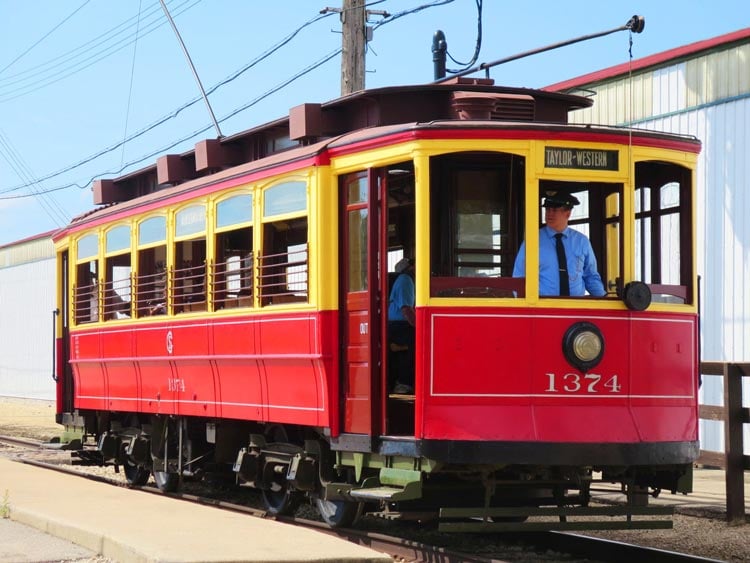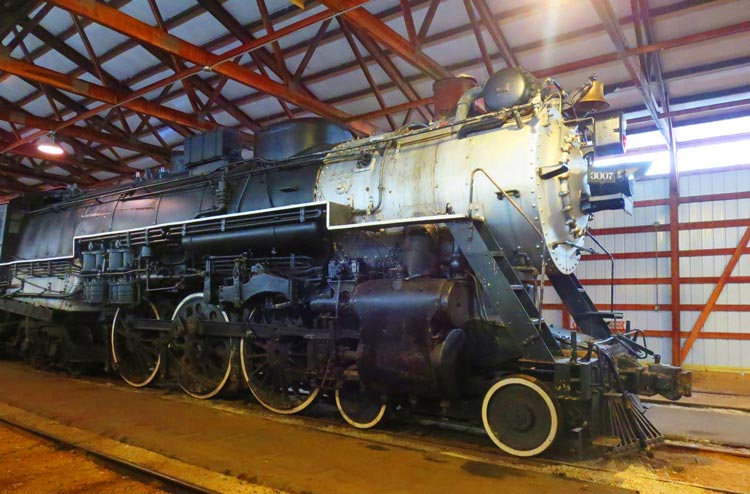
Go World Travel is reader-supported and may earn a commission from purchases made through links in this piece.
Idling beneath the shade of a small grove of trees, the rhythmic cadence of steam pulsating through the smoke stack of the Lima-built Shay reminded me of an elite athlete‘s measured breathing while awaiting the start of a new contest.
Suddenly, as though lurching from the starting blocks, a blast of inky black smoke burst from the stack in a towering display as the unique, side-mounted drive shaft spun into action propelling the 70-ton locomotive forward, pulling with a metallic jerk, the four cabooses that trailed it onto the rail siding next to the wood-built depot where we awaited to board.

Illinois Railway Museum
The Illinois Railway Museum was founded in 1953. In 1964 it relocated to an empty field east of Union, IL, just 20 miles from the Wisconsin border.
Initially, a mile and a half of right-of-way and a small 26-acre plot where the depot now sits were purchased and housed approximately 40 pieces of railroad equipment.
Today, it’s the largest railroad museum in the United States with some 450 pieces of equipment, and over 100 acres of land owned by the museum.
Based on the enthralled, wide-eyed enthusiasm of the several children we saw running towards the shiny, black behemoth to get a closer look, it might be said that the Illinois Railway Museum is also the largest train-set in the nation, eliciting smiles from children of all ages as though they were unwrapping a Lionel train on Christmas morning.
Best Tips & Tools to Plan Your Trip
We had arrived just in time for the 10:00 AM museum opening on a bright, cloudless Saturday. Based on the cars quickly filling the parking lot, several families had the same idea. By noon, the population of the Village of Union of 580 had easily doubled if not more.
Entering the grounds along Central Ave., we turned right onto Depot Street and headed towards a set of service tracks where an idling steam engine was being “coaled up” by an aged crane with a clam-shell bucket. The simple process of fueling one of these massive mechanical wonders was fascinating.
Nearby, there are several expansive red-roofed display “barns” that house many of the museum’s restored and one-of-a-kind treasures spanning over a century-and-a-half of rail history, including a horse-drawn trolley car, built in 1859, from one of Chicago’s earliest streetcar lines.

Train To Railway Museum Exhibits
An intercom announcement alerting us to the imminent departure of the day’s first excursion hurried us towards the depot, an 1851 structure that had been moved from the small town of Marengo to its current location.
The train of 4 colorful cabooses of various vintages quickly filled up as we boarded a deep maroon colored Great Western steel car built in 1946.
We awkwardly scrambled into the cupula which is akin to climbing playground monkey bars. With a blast of the steam whistle, we were on our way with the accompanying squeals of delight from several children and maybe 1 or 2 from my wife.
The train trip over the museum’s five-mile mainline railroad takes roughly 45 minutes including a brief stop to allow for photographs.
With the clickety-clack of the rail keeping time and accompanied by the occasional toot of the whistle, we chugged past corn fields and Illinois prairie, feeling the breeze in our hair, and just the occasional spent cinder from the engine’s smoke stack finding its way through the open windows.

Central Diner
Afterward, we found a picnic table and spread out our lunch. The Central Diner, an original 1930s roadside diner, does provide dining options on the weekends, but we chose to eat al fresco, watching an electric-powered red trolley making its rounds on a mile-long loop of track, which wraps around the museum allowing patrons to jump on and off at various stops.
After lunch, we explored the numerous exhibits. In Barn 3, we climbed aboard a historic Pullman passenger car and saw what luxury travel was like 60 or 70 years ago.
We entered a refrigerated boxcar, or “reefer,” and discovered how the invention of refrigerated railway cars revolutionized American life. We also saw a massive wedge-nosed snow plow that was used to clear snow from the railroad tracks.

Barn Exhibits
Barn 9 is one of the more sought after exhibit buildings. There we found the true giants of the rails: huge steam engines from the golden age of rail travel including a 4-6-4 “Hudson” passenger locomotive from the Chicago Burlington & Quincy whose 7’ steel wheels towered above us.
There were powerful streamlined electric locomotives like the iconic GG1, and the most famous train at IRM, the stainless steel streamlined Nebraska Zephyr.
While passing from one barn to the next, we stumbled upon some exhibit cars housed outside in Yard 5, where we discovered a vast display of the colorful history of railroad china and what dining on the rails in its heyday meant.
In barn 7 we explored the history of street railways in America, starting with the aforementioned horse- drawn car to the colorful turquoise and salmon red of The North Shore Electroliner of the 1940’s.
Besides the many barns, dozens of pieces of vintage equipment that have been saved or donated are stored outside throughout the grounds, many awaiting eventual refurbishments. Several restoration projects appeared to be underway in the shop areas.
Mid-afternoon brought the iconic words, “All aboard” as the museum’s St. Louis – San Francisco Railroad (“Frisco”) steam engine rolled into the station pulling a string of passenger cars. We boarded a 1914-built coach car from Delaware Lackawanna & Western Railroad and settled in for the classic passenger-train experience.

All Aboard
As we pulled away, we met our conductor, Bob Neil, one of the hundreds of volunteers who preserve and restore the exciting museum‘s railway equipment, run the trains, punch the tickets, and maintain the museum’s track and infrastructure.
While pointing out some of the vintage advertising still adorning our coach, he explained he got involved after he retired “for something to do” and loved it. That appeared to be the sentiment of all of the volunteers we met, many of whom had no previous experience with railroads.
Bob went on to explain that the engine conveying us this time was a “Russian Decapod”. The 100-ton, 71’ long steam engine was built in 1918 for export to Russia but was embargoed when the Revolution took place. Instead, the newly-completed engine was sold to the Frisco, which used it in both freight and passenger service into the 1950s.
Historic railway equipment like the Frisco’s decapod or the Burlington’s Zephyr have also helped to lend a bit of authenticity to the world of make-believe. Both the station and the trains of the IRM have made appearances in movies and on TV.
Scenes in “A League of Their Own” and the biography film “The Babe” were filmed on the premises. Most recently, the TV show “Chicago Fire” filmed an elaborate crash scene on the grounds.

Illinois Railway Museum Activities
In addition to the daily operations and activities, a number of different special events are held at the museum throughout the summer. These include Diesel Days and the Vintage Transport Extravaganza, one of the largest antique vehicle shows in the state.
The most popular event is always Day out with Thomas in which full-size versions of Thomas the Tank engine and his friends make an appearance at the museum.
As we returned to the station, unexpected and fast moving storm clouds raced across the horizon and burst upon our heads, the cool raindrops exploding into steam as they cascaded onto the hot boiler of engine 1630.
The rains brought an abrupt halt to our rail experience, but it failed to dampen our experience. As we left, I couldn’t help but smile as another blast of the steam whistle echoed across the Illinois countryside.

If You Go To The Illinois Railway Museum:
On weekends, the Museum grounds open at 10:00 am and close one hour after the last train departure unless otherwise announced. Electric cars and steam or diesel trains operate hourly 11:00 am-4:00 pm.
Weekend fares – May through September – $16 for Adults & $9 for children 11 and under. Tickets are good for unlimited rides Weekdays (except holidays) $12 Adults $9 Children
The museum is located at 7000 Olson Road, Union, Illinois, off US Highway 20 and Illinois Route 123, about halfway between Rockford and Elgin and roughly 2 hours north of Bourbonnais.
Author’s Bio: Frank Hosek is an Illinois-based Director of Human Resources who revels in traveling with his wife, Kathy. He enjoys discovering new experiences, meeting the people that make those experiences enjoyable, and sharing their adventures. He is a freelance writer for newspapers and travel websites.
- The Low-Key Magic of Ghent, Belgium - April 22, 2024
- Discover the Hidden Charm of Extremadura in Spain - April 20, 2024
- Life of a Champion: Exploring the Muhammad Ali Center in Louisville - April 19, 2024
